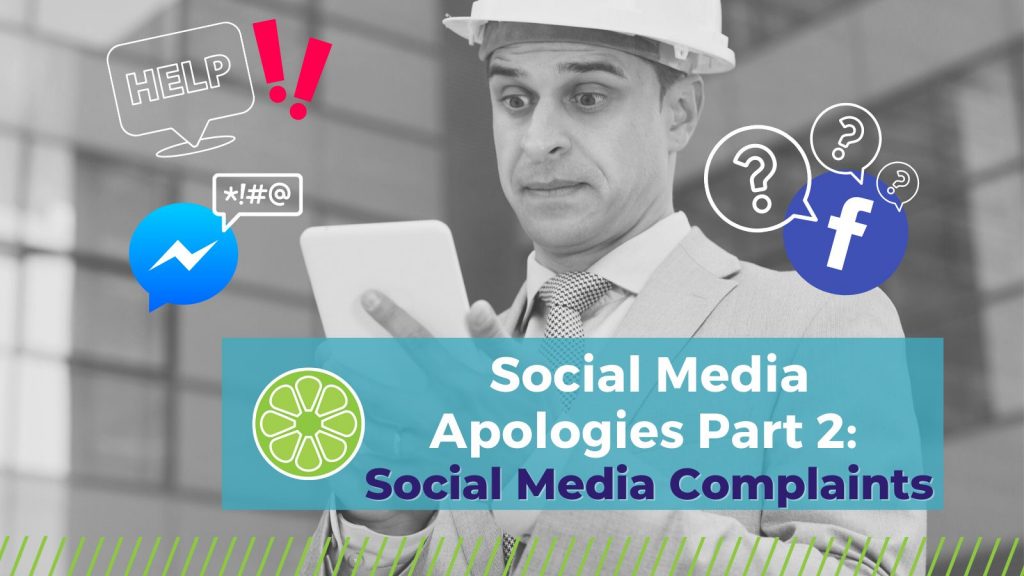5 min. read
In our last blog, we handled the dos and don’ts of social media apologies during a large-scale social media crisis. Today, we’re going to narrow our focus to crafting apologies for individual consumer complaints. Delays, outages, supply issues, and more spur customers to grab their phones and share their dissatisfaction with you and anyone else online who will listen. Without a dedicated customer service support staff or social media manager to address them, these complaints can result in lost customers, a damaged brand reputation, or worse, a full-blown social media crisis. Read on for Sublime Media Group’s Dos and Don’ts for social media apologies in response to routine customer complaints.
Don’t: Forget the Basics.
Complaints come from frustration. Social media complaints, with the barrier of a screen, are even more emotionally charged. What rings true for customer service in person remains true online:
- Exercise empathy and proactive positivity.
- Offer some form of compensation for their trouble, if possible.
- Ensure that the customer knows that their issue is important to you and someone is working to take care of them.
Overall, aim to provide your customer with the same level of service (or better service) that they would find in your in-person location.
Do: Assign Respondents.
Recall from our last blog that social media listening, the act of monitoring mentions and discussions of your brand online, is key to staying on top of negative comments. You should designate team members to check platform notifications and listening streams daily to quickly identify issues and complaints. Whoever is assigned to respond to comments and messages should be comfortable with your brand voice. They should also have reliable contact with a seasoned employee for any complaints beyond their technical or procedural knowledge.
Do: Take it to the DM’s.
When addressing a routine complaint on social media, the best thing to do is to deal directly with the individual in private. Working through potential solutions in public view leaves you vulnerable to negative opinions from users who aren’t involved. Direct or private messaging the unhappy customer also allows you to obtain more personal information to effectively seek a solution to their problem.
Beware that private messages can be made public anytime, however. General Mills recently faced serious allegations about food safety from a public figure, @JensenKarp, over stomach-churning findings in a box of cereal.
After direct messaging Karp, Cinnamon Toast Crunch dismissed his claim publicly, prompting Karp to screenshot, post, and criticize their rejected attempt to resolve the situation by DM.
I think we’ve all dated someone like Cinnamon Toast Crunch. pic.twitter.com/YH1ZtBUXF0
— Jensen Karp (@JensenKarp) March 22, 2021
Do the best you can to take the conversation private, then keep it there through satisfactory customer service.
Do: Analyze Your Role.
Now it’s time to construct your apology. Apologies can be categorized as sympathetic or responsible. So when is it better to admit that a problem was your fault, and when is it better to just say “sorry”?
Responsible Apologies
If you are at fault for a crisis, taking responsibility can help customers feel informed. Take this example from H&M Customer Service.
Hi Carolina! We do apologise as this is an IT issue. We aim to get this resolved as soon as possible.
— H&M Customer Service (@hm_custserv) December 8, 2018
H&M took responsibility for the customer’s problem, explained, and gave an update on the current situation. Even though the problem remained, the customer was no longer in the dark and could expect that the issue would likely be resolved soon. There’s value in honesty and transparency!
Sympathetic Apologies
If the crisis was caused by external factors or if the customer is at fault, a sympathetic apology can do the trick.
So thanks @UberEats I have 2 transactions being deducted from my bank account that was not me so now it is apparently my job to find out why!!!
— Sara (@Sara26137466) January 31, 2021
There was not enough information from this customer for Über to take the blame for what happened. Rather than incriminate themselves unnecessarily, Über sympathizes with the customer and offers to investigate further (notice: in the DM’s!).
We understand this experience was less than ideal. To locate the charges, please send us a DM with your phone number associated with your Uber account as well as the date of the charge, exact amount, and the last 4 digits of the card, so we can assist.
— Uber Support (@Uber_Support) January 31, 2021
Don’t: Wait.
The very nature of social media is instant. This means that whether a Tweet or Facebook comment is a last-ditch effort or the first attempt your customer makes to seek assistance, they chose social media because they need help now. Do your best to respond to complaints in 24 hours. Even if the customer’s problem is resolved before you address it, your response indicates a commitment to their needs and can serve to build rapport.
Contact us to learn how we can provide your business with dedicated social media marketing and management services.

